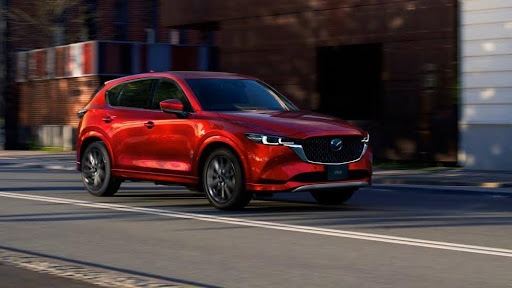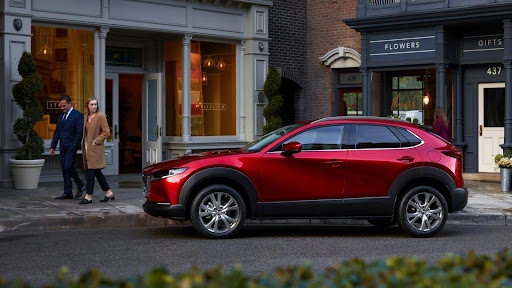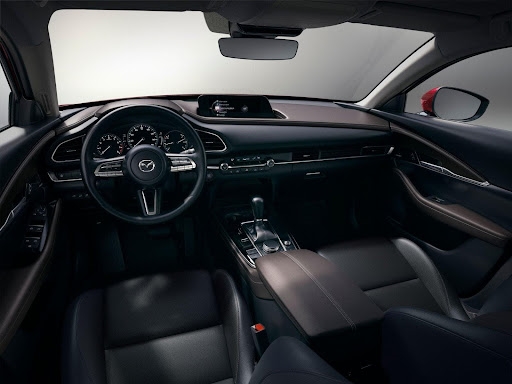
When comparing two standout models from Mazda’s crossover lineup, the Mazda CX-5 and Mazda CX-30, you’ll notice plenty of similarities—but also key differences that can significantly affect your driving experience. Whether you’re a family in search of space, a commuter prioritizing fuel economy, or an adventure-seeker looking for performance and all-weather capabilities, understanding the distinctions between these two SUVs is crucial.
If you're shopping near Orange County, Tustin Mazda, part of Patterson Autos, offers a variety of new Mazda SUVs and expert insight to help you decide between the CX-5 and CX-30.
Below, we break down the top differences between the Mazda CX-5 and CX-30, from size and performance to features and fuel economy.
- 1. Size and Interior Space
- How do the Mazda CX-5 and CX-30 compare in size?
- The Mazda CX-5 is classified as a compact SUV, while the CX-30 falls into the subcompact SUV category. This difference is apparent the moment you step inside each vehicle.
- Mazda CX-5 Dimensions
• Passenger Volume: 103.6 cu ft
• Cargo Space: 30.8 cu ft behind the second row (59.3 cu ft with seats folded)
Mazda CX-30 Dimensions
• Passenger Volume: 94.1 cu ft
• Cargo Space: 20.2 cu ft behind the second row (45.2 cu ft with seats folded)
Verdict: If interior space is a top priority—especially for families—the CX-5 offers significantly more room. The CX-30 is better suited for individuals, couples, or urban drivers needing a nimble, smaller SUV.
2. Performance and Engine Options
CX-5 horsepower vs CX-30: What’s under the hood?
Both the Mazda CX-5 and CX-30 offer two engine options, including a turbocharged variant for drivers looking for more power.
Mazda CX-5
• Standard: 2.5L 4-cylinder (187 hp)
• Available: Turbocharged 2.5L (up to 256 hp with premium fuel)
Mazda CX-30
• Standard: 2.5L 4-cylinder (191 hp)
•Available: Turbocharged 2.5L (up to 250 hp with premium fuel)
Both SUVs feature standard i-ACTIV all-wheel drive, enhancing traction and control.
Verdict: In terms of raw power, the CX-5 edges out the CX-30, especially when comparing turbo models. If horsepower and towing (CX-5 max towing capacity: 2,000 lbs) are important to you, the CX-5 delivers more muscle.

3. Fuel Economy
What’s the difference in gas mileage between CX-5 and CX-30?
Fuel efficiency can be a deciding factor, especially for daily commuters. Mazda CX-30 MPG (FWD)
• Up to 26 city / 33 highway
Mazda CX-5 MPG (FWD)
• Up to 26 city / 31 highway
Verdict: The Mazda CX-30 slightly outperforms the CX-5 in highway fuel economy, making it a stronger pick for fuel-conscious drivers. The difference is minor but could add up over time.
4. Interior Features and Comfort
CX-5 interior features vs CX-30: Which feels more premium?
Mazda consistently offers upscale interior finishes, even in its entry-level trims. However, the CX-5 takes the lead in comfort and luxury features.
Mazda CX-5 Highlights
• Available ventilated front seats
• Standard dual-zone climate control
• More rear legroom and cargo flexibility
Mazda CX-30 Highlights
• Available leather upholstery
• Standard 8.8" infotainment display
• Slightly more modern dashboard layout
Verdict: The CX-5 is better equipped for families or those who prioritize rear passenger comfort and convenience, while the CX-30 leans more minimalist and tech-forward.
5. Family-Friendliness
Which is better for families: Mazda CX-5 or CX-30?
For parents with young children or growing families, cabin space, safety, and child-seat compatibility are major concerns. CX-5 Family Perks
• More cargo capacity for strollers and gear
• Easier access to LATCH anchors
• Extra headroom and legroom in the back
CX-30 Family Perks
• Still fits child seats, but tighter configuration
• Excellent safety ratings
Verdict: The CX-5 wins as the more family-friendly Mazda SUV, especially for multi-passenger trips or daily school runs.

6. Snow & All-Weather Performance
Is the CX-30 or CX-5 better for snow driving?
Thanks to standard all-wheel drive on both models, either SUV is suitable for winter conditions. However, ground clearance and torque distribution can affect performance.
CX-5 Ground Clearance: 7.6 inches
CX-30 Ground Clearance: 8.0 inches
While the CX-30 offers slightly better ground clearance, the CX-5's heavier build and stronger turbo variant can provide more stable handling in slick conditions.
Verdict: Both SUVs handle well in snow, but the CX-30’s ground clearance gives it a slight edge for light off-roading or deeper snow, while the CX-5 offers more torque for highway control.
7. Technology and Infotainment
Both vehicles share Mazda’s intuitive infotainment system with Apple CarPlay™ and Android Auto™, but the CX-5 offers some added tech perks:
CX-5
• 10.25” center display (standard on most trims)
• Optional Bose® 10-speaker audio system
CX-30
• 8.8” center display
• Bose® system available only on higher trims
8. Pricing and Value
While both models offer strong value, the CX-30 comes in at a lower starting MSRP, making it a budget-friendly option.
CX-30 Starting MSRP: ~$24,995
CX-5 Starting MSRP: ~$29,300
Verdict: For drivers wanting affordable access to a premium compact SUV, the CX-30 offers impressive value, while the CX-5 brings more features and space at a slightly higher cost.
Final Thoughts: CX-5 vs CX-30 — Which One Is Right for You?
If you value space, performance, and family versatility, the Mazda CX-5 is the stronger option. However, if you prefer compact size, fuel efficiency, and modern styling at a lower price, the Mazda CX-30 is a smart, well-rounded choice.
No matter which you’re leaning toward, both vehicles offer the elevated driving dynamics and quality materials Mazda is known for. Visit Tustin Mazda, proudly part of Patterson Autos, to test drive both SUVs and find the perfect fit for your lifestyle.